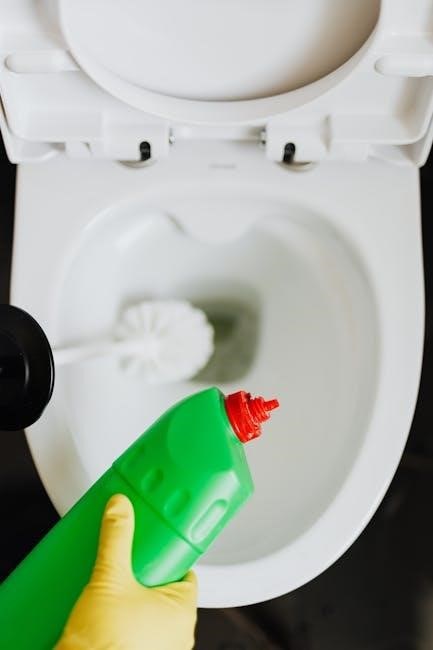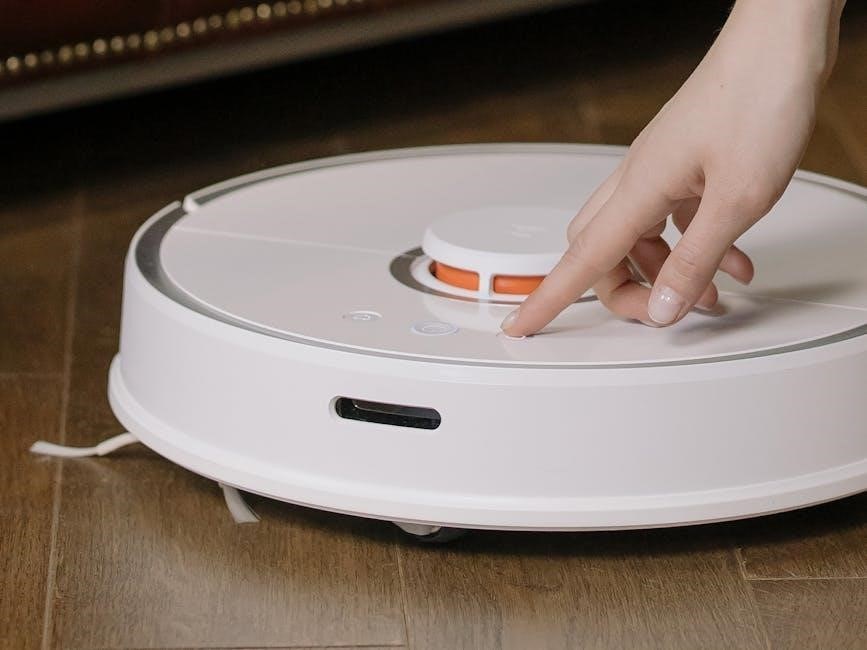hoover h-wash 300 user manual
The Hoover H-Wash 300 is a versatile washing machine designed for efficient cleaning, offering multiple wash cycles and energy-saving features; Its user-friendly interface ensures easy operation.
1.1 Overview of the Hoover H-Wash 300 Washing Machine
The Hoover H-Wash 300 is a reliable and efficient washing machine designed to meet everyday laundry needs. It features a range of wash programs, including quick cycles and eco-friendly options. With a generous capacity and energy-saving technology, it ensures thorough cleaning while reducing energy consumption. The machine is user-friendly, with a clear control panel and durable construction. It also includes special functions like variable spin speeds and temperature control, making it suitable for various fabric types. This model is ideal for households seeking a balance between performance and affordability.
1.2 Key Features and Benefits
The Hoover H-Wash 300 offers energy efficiency with its A-class rating, reducing power consumption while delivering excellent cleaning results. It features multiple wash cycles, including quick wash and eco modes, catering to different fabric types. The machine is equipped with a user-friendly control panel and advanced noise reduction technology for quieter operation. Its spacious drum capacity accommodates large loads, making it ideal for families. These features combine to provide a practical, innovative, and cost-effective laundry solution for everyday use.

General Safety Rules
Always follow safety guidelines to avoid accidents. Keep children away, avoid hot water splashes, and ensure proper installation. Use original parts and follow manual instructions carefully.
2.1 Safety Precautions Before Use
Before using your Hoover H-Wash 300, ensure all safety precautions are met to prevent accidents. Check that the machine is stable and level to avoid vibrations. Never overload the detergent drawer, as this can cause leaks. Always ensure the drum is empty before starting a cycle. Read and follow the instructions on detergent labels carefully. Use only genuine Hoover parts to maintain safety standards. Keep children away from the machine and ensure they do not play with the controls. Regularly inspect hoses and connections for signs of wear. Finally, ensure the area around the machine remains dry to prevent slipping hazards.
2.2 Important Safety Instructions for Operation
Always follow the user manual to ensure safe operation of your Hoover H-Wash 300. Before each cycle, check pockets for coins or metal objects to prevent damage. Avoid leaning on the machine while it’s running. Keep the drum clean to maintain performance. Do not leave flammable materials near the machine. Supervise children when the machine is in use. Only use genuine Hoover parts for repairs. Be cautious of hot surfaces after a cycle.

Installation Requirements
Proper installation ensures optimal performance and safety. Place the machine on a stable, level surface and ensure good ventilation. Follow all guidelines for correct setup and operation.
3.1 Proper Placement and Leveling of the Machine
Ensure the Hoover H-Wash 300 is placed on a stable, level surface to prevent vibration and noise. Adjust the machine’s feet to achieve even balance. Avoid placing it on uneven or soft floors, as this may cause instability. Check that the floor can support the machine’s weight when fully loaded. Proper leveling ensures smooth operation and reduces the risk of damage or excessive noise during use. Use a spirit level for accuracy and adjust the feet as needed for optimal performance.
3.2 Connecting Water Supply and Drainage
Connect the Hoover H-Wash 300 to a cold water supply using the provided inlet hose. Ensure the water supply is turned off before connecting. Check for leaks after installation. For drainage, position the drain hose at least 50cm above floor level to prevent backflow. Avoid kinking or bending the hoses. Use the factory-fitted hoses to maintain compatibility. Ensure the drain pipe is securely connected to prevent water spillage. Regularly inspect hoses for damage or wear and replace if necessary to maintain efficient operation.
3.3 Electrical Installation Guidelines
Ensure the Hoover H-Wash 300 is connected to a 230V, 50Hz power supply. Use the original power cable provided to avoid damage. Do not use extension cords or multiple sockets. The power socket must have an earth connection for safety. Keep the machine away from water sources to prevent electric shock. Regularly inspect the power cord for damage or wear. If damaged, replace it immediately to avoid hazards. Always unplug the machine during maintenance or repairs for added safety.

Understanding the Detergent Drawer
The detergent drawer is designed for optimal wash performance. It has separate compartments for pre-wash, main wash, and fabric softener. Always use the recommended detergent quantities.
4.1 Correct Use of the Detergent Compartment
The detergent compartment is divided into three sections: pre-wash, main wash, and fabric softener. Always use the recommended detergent quantities to avoid overfilling. Place powder or liquid detergent in the appropriate slots. For optimal performance, ensure the drawer is closed properly after adding detergent. Avoid mixing different types of detergent. Refer to the user manual for specific guidelines on detergent usage and compatibility with the Hoover H-Wash 300.
4.2 Recommended Detergent Types and Quantities
Use low-foam detergents specifically designed for automatic washing machines. Liquid, powder, or single-dose packets are suitable. Follow the detergent manufacturer’s dosage instructions. The recommended quantity varies based on load size, soil level, and water hardness. Avoid overloading the detergent drawer to prevent residue buildup. For optimal results, adjust detergent amounts according to the cycle selected and fabric type. Always refer to the user manual for specific guidelines on detergent usage for the Hoover H-Wash 300.
Practical Hints for Optimal Use
Sort clothes by fabric type and color to prevent damage. Avoid overloading the machine for optimal cleaning. Use the eco-mode for energy efficiency and gentler cycles.
5.1 Sorting and Loading Laundry
Sort clothes by fabric type, color, and delicacy to prevent damage. Separate heavily soiled items from lighter ones. Check pockets for loose objects to avoid damage. Load evenly, ensuring clothes move freely. Avoid overloading, as this reduces efficiency. Use the correct detergent quantity for load size. Distribute items evenly for balanced washing. Ensure delicate fabrics are placed in a mesh bag. Avoid mixing large and small items to prevent tangling. Keep the drum 2/3 full for optimal performance.
5.2 Selecting the Right Wash Cycle for Fabric Types
Choose cycles based on fabric type for optimal results. Delicates require gentle settings, while heavier fabrics like cotton benefit from standard or intense cycles. Woolens need specific programs to prevent shrinkage. Synthetic fibers work well with quick or eco modes. Always check care labels for fabric-specific instructions. Adjust settings for soil level and color preservation. Use pre-wash options for heavily soiled items. Consult the manual for detailed cycle recommendations tailored to your load.
5.3 Energy-Saving Tips
Optimize energy usage by selecting eco-friendly cycles and lower temperatures. Use the Eco Mode for reduced energy consumption. Ensure full loads to minimize cycles. Regularly maintain the machine to prevent efficiency loss. Check energy class ratings for eco-conscious operation. Avoid unnecessary pre-washes and utilize the machine’s energy-saving features. Proper detergent dosage also enhances efficiency. Refer to the manual for cycle recommendations tailored to energy conservation.

Cleaning and Maintenance
Regular cleaning of the filter and drain pump ensures optimal performance. Maintain the detergent drawer and gasket to prevent mold and odors. Follow manual guidelines for upkeep.
6.1 Cleaning the Filter and Drain Pump
Regular cleaning of the filter and drain pump is essential for maintaining your Hoover H-Wash 300’s performance. Start by turning off the machine and unplugging it for safety. Locate the drain pump filter, usually found at the bottom of the machine. Open the filter compartment and remove any debris or blockages. Rinse the filter under running water and ensure it is clean before reinstalling. This process prevents clogs and ensures smooth operation. Additionally, check the drain hose for kinks or obstructions. Cleaning these components regularly helps maintain efficiency and prevents odors.
For best results, clean the filter after every 10 wash cycles. If you notice reduced drainage, it may indicate a blockage. Always refer to your user manual for specific instructions tailored to your model. Proper maintenance ensures optimal functionality and extends the lifespan of your washing machine. Regular checks and cleaning also help prevent costly repairs and keep your laundry fresh.
6.2 Maintaining the Detergent Drawer and Gasket
Regularly clean the detergent drawer to prevent residue buildup. Remove the drawer, rinse it under warm water, and dry thoroughly before reinstalling. Check for blockages in the drawer’s compartments to ensure proper detergent distribution. For the gasket, wipe it with a damp cloth after each use to remove mold or mildew. Leave the lid open after washing to allow the gasket to dry completely. This maintenance prevents odors and ensures optimal performance. Clean the gasket every 1-2 months for best results.
6.3 Regular Maintenance to Prevent Odors
Regularly clean the interior to prevent odors. Run a hot water cycle with a washing machine cleaner or vinegar to eliminate bacteria and mold. After each use, leave the lid slightly open to allow moisture to evaporate. Clean the gasket and detergent drawer frequently. Avoid leaving wet laundry inside for extended periods. For best results, perform a maintenance cycle every 1-2 months. This routine ensures a fresh-smelling machine and optimal performance.

Quick User Guide
Start by adding detergent, select the desired cycle, and press Start. Monitor progress via the display. Ensure the lid is closed during operation for optimal results.
7.1 Starting a Wash Cycle
To start a wash cycle, first, ensure the detergent drawer is filled correctly. Load laundry, avoiding overfilling. Close the lid securely. Select the desired program using the control panel, adjusting settings like temperature and spin speed if needed. Press the Start button to begin. The machine will automatically detect load size and adjust water usage. Monitor the display for cycle progress. For energy efficiency, use the Eco Mode option when available. Always ensure the lid remains closed during operation to maintain performance and safety.
7.2 Navigating the Control Panel
The Hoover H-Wash 300 features an intuitive control panel with clear buttons and an LED display. Start by pressing the Power button to activate the machine. Use the Program Selection buttons to choose the desired wash cycle, with options for delicate, normal, or heavy-duty cleaning. Adjust settings like spin speed and temperature using the corresponding buttons. The LED display shows the selected program, remaining time, and any active options. For added convenience, the Delay Start function allows scheduling the cycle. Press Start/Stop to begin or pause the wash. The control panel is backlit for better visibility.
7.3 Pausing or Canceling a Cycle
To pause the Hoover H-Wash 300, press the Start/Stop button; The machine will halt temporarily, allowing you to add or remove items. To cancel a cycle, press and hold the Start/Stop button until the display clears. Note that some models may require holding the button for a few seconds. Once canceled, the machine will drain and stop. Always ensure the door is closed properly before resuming operation. This feature provides flexibility for uninterrupted laundry management.

Controls and Programmes
The Hoover H-Wash 300 features intuitive controls with a variety of wash programmes tailored for different fabric types and soil levels, ensuring efficient and tailored cleaning results.
8.1 Explanation of Wash Programmes
The Hoover H-Wash 300 offers a range of preset wash programmes tailored for specific fabric types and soil levels. These include programmes for cotton, synthetic, delicate, wool, and quick wash. Each programme adjusts water temperature, wash intensity, and spin speed to ensure optimal cleaning while protecting fabrics. Additional options like eco mode and silent operation provide flexibility for energy efficiency and noise reduction, catering to various household needs and preferences.
8.2 Adjusting Temperature and Spin Speed
The Hoover H-Wash 300 allows users to customize wash cycles by adjusting temperature and spin speed; Temperature settings range from cold to hot, suitable for different fabric types and soil levels. Spin speed can be set to low, medium, or high, depending on the fabric delicacy and desired drying efficiency. Adjusting these settings ensures optimal cleaning while protecting garments. Always refer to fabric care labels for recommended settings to prevent damage. This feature enhances versatility for various laundry needs.
8.3 Special Functions and Options
The Hoover H-Wash 300 offers a range of special functions to enhance your washing experience. These include a delayed start option, allowing you to schedule wash cycles in advance. The eco mode reduces energy consumption while maintaining effective cleaning. Additionally, a quick wash function is available for lightly soiled garments, saving time. Some models also feature a child lock to prevent accidental changes to settings. These options provide flexibility and convenience, catering to various household needs.

Drying Cycle
The Hoover H-Wash 300 offers an efficient drying cycle designed to protect fabrics while ensuring optimal drying results. Energy-efficient modes help reduce consumption during the drying process.
9.1 Using the Drying Function Effectively
To use the drying function effectively, ensure the drum is not overloaded, as this can reduce efficiency. Select the appropriate drying mode based on fabric type and desired dryness level. For delicate items, choose a lower heat setting to prevent damage. Regularly clean the lint filter to maintain airflow and efficiency. Always refer to the user manual for specific settings and guidelines for optimal performance and fabric care.
9.2 Tips for Efficient Drying
For efficient drying, ensure the drum is not overloaded, as this hinders airflow. Use the moisture-sensing feature to avoid over-drying clothes. Regularly clean the lint filter to improve airflow and efficiency. Sort clothes by thickness to ensure even drying. Use the correct drying mode for fabric types to prevent damage. Avoid drying delicate fabrics at high temperatures. Consider using the eco-mode for energy savings. Always refer to the user manual for specific settings and fabric care guidelines to optimize drying performance.
Automatic Washing/Drying Cycle
The Hoover H-Wash 300 offers a convenient automatic washing/drying cycle, combining both processes in one go. It uses advanced sensors to adjust settings for optimal results.
10.1 How the Combined Cycle Works
The Hoover H-Wash 300’s automatic washing/drying cycle uses advanced sensors to detect load size and fabric type. It automatically selects optimal wash and dry settings, ensuring efficient cleaning and energy savings. The cycle starts with a wash phase, followed by a drying phase using heated air circulation. The machine adjusts temperature and spin speed to prevent damage to fabrics. This combined process simplifies laundry tasks, offering convenience and consistency for users.
10.2 Benefits of Using the Auto Cycle
The auto cycle on the Hoover H-Wash 300 offers unmatched convenience, combining washing and drying in a single process. It saves time by eliminating the need to transfer clothes, ensuring continuous laundry care. The machine’s sensors optimize water, energy, and heat for each load, reducing effort and ensuring gentle fabric care. This feature is ideal for busy households, providing a hassle-free solution for clean and dry laundry with minimal supervision required.

Troubleshooting Common Issues
This section helps identify and resolve common problems, such as error codes, noise, or malfunction, ensuring smooth operation of your Hoover H-Wash 300 washing machine.
11.1 Identifying and Solving Error Codes
The Hoover H-Wash 300 displays error codes to indicate specific issues. Codes like E01, E02, and E03 often relate to sensor malfunctions, drainage problems, or power supply issues. Refer to the manual for a full list of codes and their meanings. To resolve errors, check the filter, ensure proper drainage, and restart the machine. For persistent issues, consult customer support or a professional technician to avoid further damage. Regular maintenance can help prevent these errors. Always follow the manufacturer’s guidelines for troubleshooting.
11.2 Common Problems and Their Solutions
Common issues with the Hoover H-Wash 300 include the machine not starting, excessive noise, or poor wash performance. Check the power supply and ensure the door is closed properly if it doesn’t start. For noise, ensure the machine is level and balanced. If clothes aren’t clean, check detergent dosage and cycle selection. Refer to the manual for guidance or contact customer support for persistent issues. Regular maintenance can prevent many of these problems. Always follow the manufacturer’s instructions for optimal performance.
Energy Efficiency and Eco Modes
The Hoover H-Wash 300 offers excellent energy efficiency with its eco-friendly modes, reducing power and water consumption. Eco Mode ensures optimal washing with minimal energy use.
12.1 Understanding Energy Classes
The Hoover H-Wash 300 features energy classes that indicate its efficiency. Class A represents the highest efficiency, minimizing energy and water usage. Lower classes offer cost-effective solutions while maintaining performance.
12.2 Using Eco Mode for Energy Savings
Eco Mode on the Hoover H-Wash 300 optimizes energy and water consumption for eco-friendly laundry. It adjusts wash cycles to reduce energy use while maintaining performance. Ideal for lightly soiled clothes, Eco Mode helps lower utility bills and environmental impact. Activate it for a greener, cost-effective solution without compromising cleaning quality. Regular use supports energy efficiency and prolongs machine lifespan.

Warranty and Customer Support
The Hoover H-Wash 300 comes with a comprehensive warranty, offering coverage for parts and labor. Customer support is available for troubleshooting and assistance.
13.1 Warranty Terms and Conditions
The Hoover H-Wash 300 is covered by a manufacturer’s warranty, typically lasting 1-2 years, depending on the region. This warranty covers defects in materials and workmanship. Registration may be required. Damage caused by misuse, improper installation, or unauthorized repairs may void the warranty. For specific terms, refer to the official Hoover website or contact customer support. Always retain the purchase receipt as proof of ownership for warranty claims.
13.2 Contacting Hoover Customer Service
For assistance with your Hoover H-Wash 300, contact customer service via phone, email, or live chat through their official website. Visit the Hoover website, navigate to the support section, and select your region for contact details. Have your model number and purchase details ready for efficient service. Customer support is available to address queries, repair requests, and warranty-related issues. Ensure to use official channels to avoid unauthorized service providers.
Quick User Guide Summary
Sort laundry by fabric type and color, ensuring even distribution. Add detergent to the drawer, select the appropriate cycle, and start the machine. For drying, choose the correct mode and temperature. Regularly clean filters and check for error codes. Refer to the manual for detailed instructions. This guide provides a quick overview for daily use, ensuring optimal performance and maintenance of your Hoover H-Wash 300 washing machine.